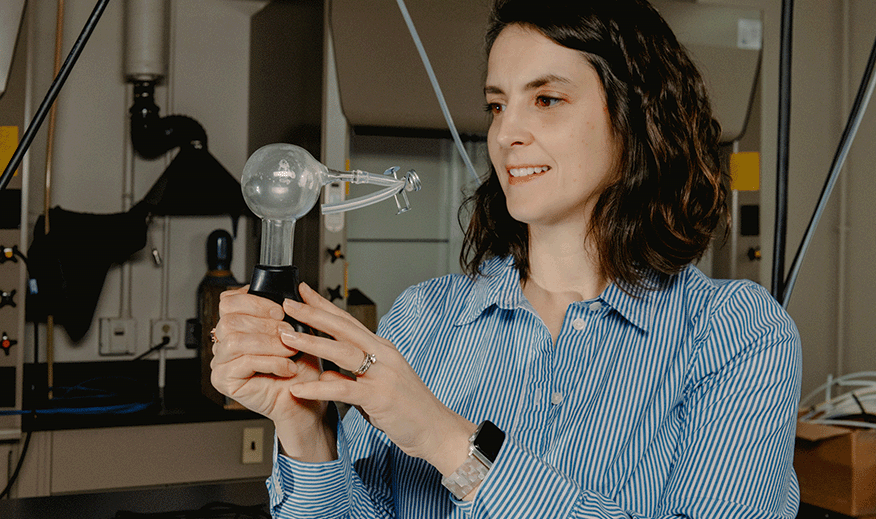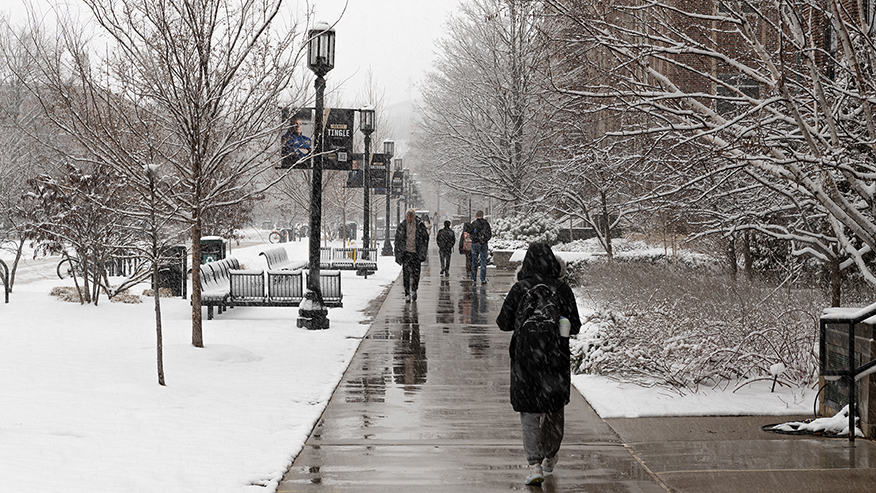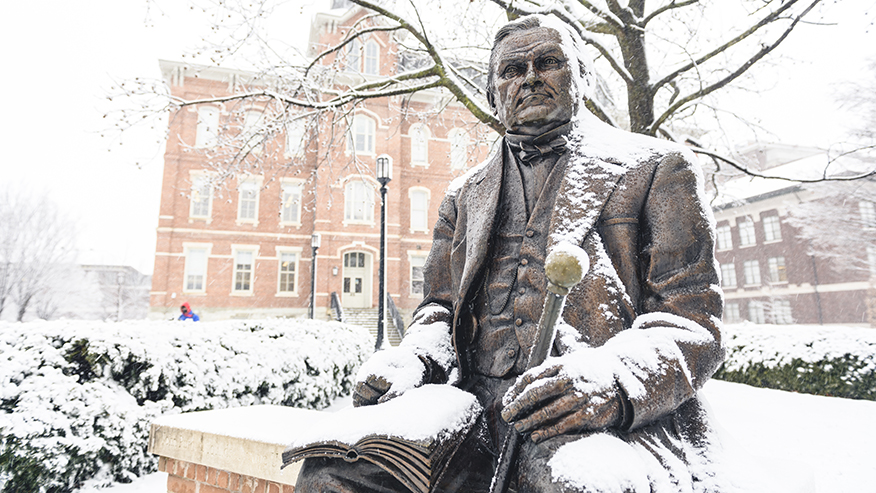Cloudy science, clear insights: Atmospheric scientist studies clouds’ causes and effects
Cloud formation and behavior in lab teach researchers about Earth, other planets

Atmospheric scientist and cloud expert Alexandria Johnson creates clouds in her lab to study atmospheric phenomena on Earth and in faraway skies. (Purdue University photo/Kelsey Lefever)
WEST LAFAYETTE, Ind. — Every cloud is lined, not with silver, but with science — at least from cloud expert Alexandria Johnson’s point of view.
Clouds are ubiquitous. They are one of the most notable characteristics of planet Earth. Studying them is akin to studying the blood and arteries of the planet itself. Johnson, an atmospheric scientist and assistant professor in Purdue University’s College of Science, studies clouds wherever they are: in her lab, on Earth, throughout the solar system and into the galaxy.
“The coolest thing about my research is that I can see clouds every day,” Johnson said. “I can look up into our own atmosphere and watch them change and evolve. Then I can take that knowledge and apply it to other planetary bodies, both within and outside our solar system.”
The science of clouds covers a lot of ground, and her research often reveals the unexpected. How to make theories about the surface of a planet from its cloudy atmosphere, for example. Or the fact that almost every milliliter of raindrops, even in the landlocked Midwest, contains a shocking amount of microplastics.
ADDITIONAL INFORMATION
Raining buckets and pouring plastics
Like a pearl forming around a speck of sand, clouds coalesce around motes of matter called nuclei. Usually, these nuclei are made of material from outside the atmosphere: a bit of space dust from a meteor skimming the atmosphere or a speck of sand kicked up from the Earth’s surface. But a new type of nuclei is beginning to play a role in natural systems: microplastics.
“Plastic doesn’t degrade,” Johnson said. “It just breaks down into smaller and smaller pieces that show up in our environments. We have found these microplastics everywhere on the planet, even in remote regions like national parks and Antarctica. However, they are found most densely where humans are because we are the source of the plastic.”
Johnson and her team, including Gouri Prabhakar, assistant professor of practice in the Department of Earth, Atmospheric, and Planetary Sciences, collected samples from several large rain and snow events at Purdue’s Agronomy Center for Research and Education in 2023. And they’ve started looking through the samples for something to catch their eyes: brightly colored blips of plastic. They have identified microplastics in every sample they’ve studied. They are now using a scanning electron microscope to find even smaller plastic pieces and better understand their properties.
Microplastics are a health and environmental concern across the globe, but most research has focused on plastics in animals’ bodies or in bodies of water. Johnson and her team are among the first to see that some of that plastic is falling from the sky in the Midwest and link it to clouds and precipitation.
“In a pristine state, plastic is hydrophobic and won’t act as cloud nuclei,” Johnson said. “However, if these microplastics reside in the environment long enough, they can become coated in organics, after which they may act as a cloud condensation or ice nuclei. These aged microplastics could be affecting clouds and precipitation patterns, the effects of which will grow with time as the number of microplastics in our environment increases.”
How to catch a cloud and pin it down

louds are difficult to study. They are, by definition, nebulous as well as enormous, and far from the comfortable climes where humans spend their lives. But understanding how they form and their physics are key to understanding weather, precipitation patterns and the planet itself.
Johnson’s solution is to grow her own clouds in her lab in the Department of Earth, Atmospheric, and Planetary Sciences. She uses minimalistic models to capture the dynamics of the systems, stripping them down to their basics to get a clear understanding on how the particles that make up clouds form, develop and interact with their environment. Using decidedly nonphotogenic setups of mostly lasers and big black boxes, Johnson’s studies show how the behavior of these lab-based cloud particles mimics the behavior of cloud particles in massive sky-sweeping clouds, only in miniature.
“Of course, we don’t grow them at quite the same scale you see in an atmosphere,” Johnson said. “Instead, we take one particle that is representative of a cloud, pump in different gases, change the temperature and pressure of the system. We then watch as that particle grows, shrinks or changes phase with time, all of which are processes that happen in clouds everywhere.”
The particles that act as the nuclei of Johnson’s lab-grown clouds, like most particles, have a charge. Johnson and her team use an electric field to levitate and contain the individual particles so they can’t move around. These particles are then stable for extended periods, which enables long-term research experiments — sometimes they stick around long enough to earn names. The scientists vary the pressure, temperature, electric field and laser illumination and study how the cloud particle reacts. Other methods build upon these to allow the team to look at groups of particles and observe how they scatter and polarize light.
Johnson can extrapolate from these systems to understand how different conditions lead to certain cloud types and behaviors. Like aeronautical engineers using a wind tunnel to observe how currents move around structures, Johnson uses these particles to understand the microphysics that underpin vast and complex systems.
Many scientists — climatologists, meteorologists and planetary scientists, to name a few — study clouds as part of their broader research. But Johnson is one of the few who studies the particular physics of clouds in the laboratory.
“There are not many of us who dig into the small-scale processes of how clouds form,” Johnson said. “Anyone who studies the atmosphere has to have a general knowledge of clouds. But none of those systems work without the microphysics driving cloud formation and evolution. We have to understand these processes to truly grasp the complexities and implications at larger scales.”
Exoplanets under the weather
It’s a long-running joke that the nights of notable astronomical events on Earth seem to be almost supernaturally disposed to be cloudy. That is true of other planets, too. Humans awaited the April 2024 solar eclipse hoping for clear skies, not clouds, a hope that was rewarded in a wide swath of the U.S.
But all too often, using enormous, advanced, vastly powerful telescopes, astronomers can peer through light-years of space just to find clouds blocking their view of the planet itself. Rather than the planet’s surface, they can only perceive the opaque atmosphere that enrobes it.
Every planetary body in the solar system that has a dense atmosphere, and many outside of it, has clouds in that atmosphere. Even bodies with thin, wispy or intermittent atmospheres — like Pluto — have particulates hanging in the atmosphere that, while not true clouds, are a haze of particles and share many of clouds’ properties.
“Clouds are a ubiquitous feature of planetary atmospheres,” Johnson said. “This is something we’ve seen from our own solar system, and when we look at exoplanet atmospheres, it’s no surprise that we find clouds there too. Unfortunately, they tend to block our view of the atmosphere and surface that below.”
Scientists have been able to send probes and rovers to close planetary neighbors, including Venus and Mars. But for bodies that are farther away, including exoplanets — planets in other star systems entirely — scientists must come up with clever ways to conduct science.
“The astronomers find the clouds to be an annoyance. They get in the way of the data they want, whether that’s learning about the surface of the planet or its atmospheric composition,” Johnson said. “We see it a little differently. Yes, they’re there and we can’t get rid of them. So let’s use our understanding of clouds on Earth and planetary atmospheres of our solar system to learn about those things that we can’t observe in exoplanets.”
Johnson and her team accumulate information about planetary bodies in Earth’s solar system or exoplanets. Astronomers can collect spectrographic data to analyze the chemical compounds that make up the atmosphere and use mathematical models, observations and gravitation studies to determine a planet’s mass, size and orbit. Combining that information with insights from her laboratory studies, Johnson can help astronomers determine what a planet’s atmosphere and clouds might be and extrapolate its chance for hosting life — helping ground-truth telescope data.
“Our big questions are when, where and why do clouds form in these atmospheres?” Johnson said. “If we want to understand these enshrouded exoplanets, we need to understand the clouds. That understanding gives us insights into the atmospheric chemistry at work, atmospheric circulations and the climate of these exoplanets. In a way, we ground-truth astronomical observations. The same physics is at work whether it’s on Earth, in my lab or on an exoplanet. It’s the same processes, all throughout the universe, and it brings me a huge amount of wonder and joy.”
About Purdue University
Purdue University is a public research institution demonstrating excellence at scale. Ranked among top 10 public universities and with two colleges in the top four in the United States, Purdue discovers and disseminates knowledge with a quality and at a scale second to none. More than 105,000 students study at Purdue across modalities and locations, including nearly 50,000 in person on the West Lafayette campus. Committed to affordability and accessibility, Purdue’s main campus has frozen tuition 13 years in a row. See how Purdue never stops in the persistent pursuit of the next giant leap — including its first comprehensive urban campus in Indianapolis, the new Mitchell E. Daniels, Jr. School of Business, and Purdue Computes — at https://www.purdue.edu/president/strategic-initiatives.
Writer/Media contact: Brittany Steff, bsteff@purdue.edu
Source: Alexandria Johnson, avjohns@purdue.edu



